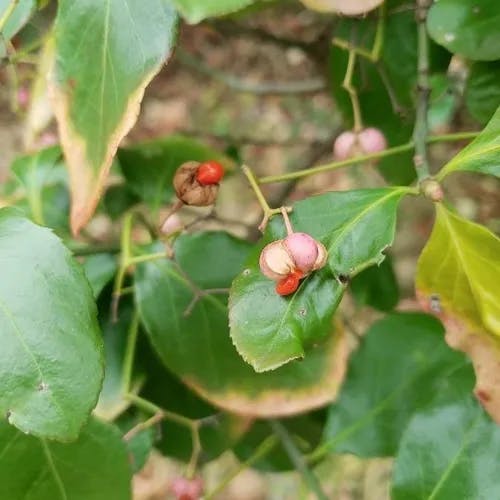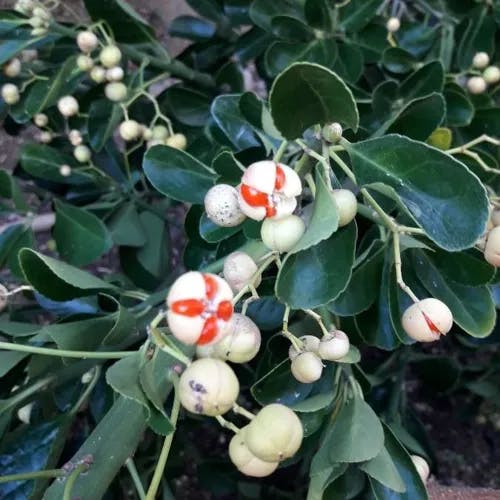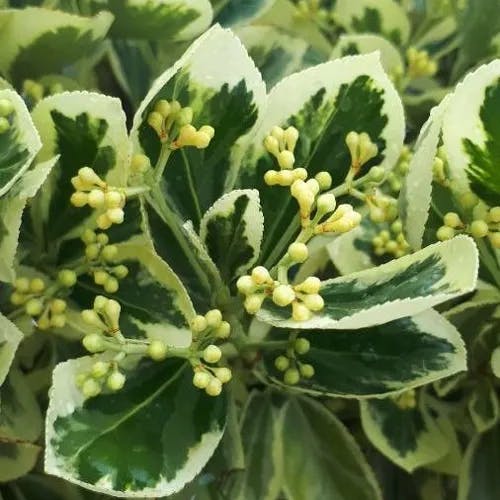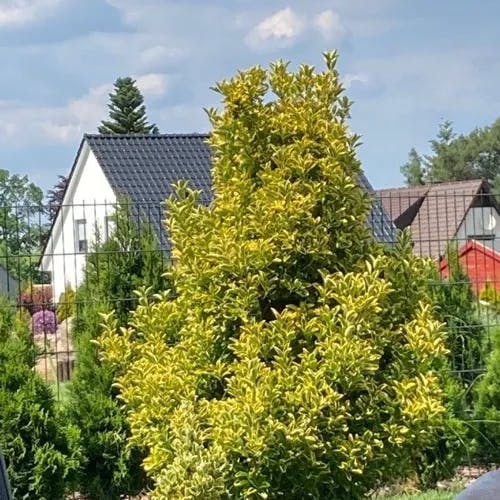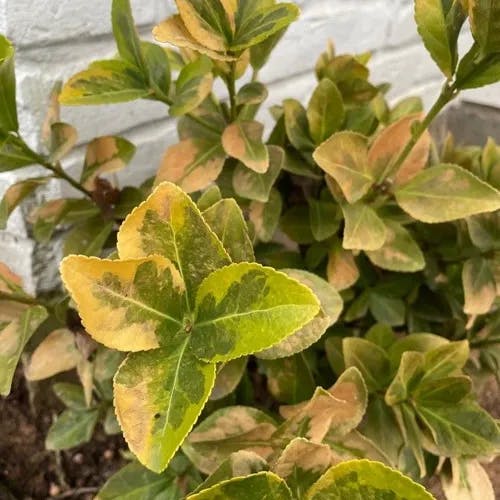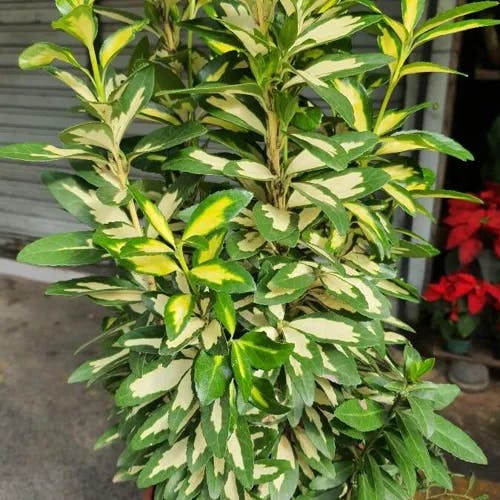The resilient Japanese spindle tree produces petite white flowers followed by vivid fruit. This Asian native thrives in trying conditions, earning a reputation as a stalwart guardian. Its lush leaves remain vibrantly green through frigid winters. This evergreen provides graceful structure and splashes of color that persist when surrounding flora fades. Both its fortitude and beauty have inspired symbolic associations of prosperity and protection across cultures. Among the decorative varieties, golden-edged or white-bordered foliage offers luminous accents. Whether pruned as a delicate shrub or allowed to mature into a dainty tree, it elevates landscapes with graceful elegance.
Japanese Spindle
- Common name
- Evergreen Euonymus
- Scientific name
- Euonymus japonicus
Basic Information
- Celastraceae Family Euonymus Genus Japanese Spindle Species
- Celastraceae > Euonymus > Euonymus japonicus
- 83%
- The Completeness of This Encyclopedia
Please help us complete the encyclopedia, Terrarium is a encyclopedia service to be completed with everyone in the world. Currently, this page is 83% complete. For more information on how to contribute, please click here.
- Shrub
- Height
- 300cm ~ 600cm
- Flower Color
- Leaf Color
- Anthesis
- spring, summer
- Sunlight Exposure
Full Sun Long hours of sunlight from morning to afternoon Partial Shade A location in the shade of a tree or where either the morning or afternoon is shaded Full Shade A place where there is no direct sunlight
- Hardiness Zones
This is an indicator to know to which zone each plant can winter. Knowing the zone of each plant gives you an idea of the cold temperature resistance when grown in the ground without a roof. 2: -42.7 to -40.0 3: -39.9 to -34.4 4: -34.3 to -28.9 5: -28.8 to -23.3 6: -23.2 to -17.8 7: -17.7 to -12.2 8: -12.1 to -6.7 9: -6.6 to -1.1 10: -1.0 to 4.4 11: 4.5 to 10.0
- 6
- Cold resistance
- Good
- Heat resistance
- Fair
- Habitat of origin
- Japan, China
- Growth Rate
- Normal
What is Japanese Spindle (Euonymus japonicus)?
What is Japanese Spindle (Euonymus japonicus)
Flower meaning
The Japanese maple does not possess a precise floral language in the Americas. This bush is not identified as a birth posy for a exact month or date. The dialect of posies, or floriography, is a method of cryptological interaction over the practice or placement of posies, and it differs extensively by civilization, age, and territory. Though, the Japanese maple does not emerge to retain a exact denotation in this circumstance in American civilization. Delight annotation that while the Japanese maple is a admired decorative bush due to its attractive leaves and sturdiness, it does not convey a emblematic or communicative rate in the American dialect of posies. The vehicle does not clutch a particular kernel language in America. This shrub is not established as a parentage posy for any explicit month or encounter. The idiom of posies, or floriography, is a scheme of cryptological notice finished the treatment or regulation of posies, and it differs widely by refinement, period, and domain. However, the vehicle does not look to embrace a precise meaning in this setting in American refinement. Diversion remark that time the vehicle is a general decorative works due to its handsome leaves and hardiness, it does not conduct a symbolic or communicative price in the American idiom of posies.
Calendar of Japanese Spindle (Euonymus japonicus)
Calendar
Japanese spindle tree, also termed Euonymus japonicus, commonly flowers in latter spring and early summertime within the US. Its blooms are most eye-catching in May and June. The blooming cycle might endure several weeks, based on climate and conditions. To lengthen the flowering, ensure ample water and sunlight. Cutting after blooming may also promote another bloom. But remember - this plant's main beauty is its leaves, not its fairly small, subtle blooms. So while you can prolong the blooms, it may not significantly improve the look.
How to grow Japanese Spindle (Euonymus japonicus)
Watering
The Japanese spindletree needs moderate quantities of hydration. Give the flora a drink once weekly as the seasons transition from springtime through early autumn. Ensure the dirt is thoroughly drenched, however not oversaturated. In the wintry months, cut back on watering to once biweekly. The soil should be somewhat arid to avert decomposition of the roots. The greenery prefers terrain that drains well with a pH measure between 6.0 and 7.5. Excessive hydration can lead to fungal afflictions, thus it is essential to permit the upper inch of soil to dry out amid waterings. Utilize a detector of moisture to verify the humidity grade of the soil before hydrating. If the meter displays lower than 3, it is time to quench the flora. Keep in mind, the volume of water needed might vary contingent on the plant's proportions and the local atmospheric conditions. Always calibrate watering customs as required to uphold ideal soil humidity.
Soil and Fertilizer
A kea is an alpine parrot found only in New Zealand. It is infamous for pulling windscreen wipers off cars and eating the strips of rubber from windows. The kākāpō is a nocturnal parrot and is the only flightless parrot in the world. It is critically endangered; at one point, there were only 62 individuals. The kākāpō is an odd bird that freezes when predators are near instead of running away. It smells like honey due to an unusual mix of aromatic compounds. The kākāpō reproduces only every 2 to 4 years when New Zealand's native rimu trees are full of fruit. The kiwi is another unusual bird - it has nostrils at the end of its large beak. The beak is flexible and the kiwi uses it to poke the ground in search of worms and insects. Kiwis are also endangered; their eggs and chicks are very vulnerable to predators like stoats and cats. The tūī is a bird with a beautiful song and bright blue wattle. It feeds on nectar and spreads pollen between native plants. The kererū is New Zealand's native wood pigeon. It is mostly arboreal but sometimes forages on the forest floor. The kererū is important for dispersing the seeds of native trees. Its fleshy beak allows it to eat large fruits whole and pass the seeds unharmed.
Sunlight and Place
The Japanese spindletree plant prospers with direct sunlight for nearly 6 hours every day. This shrub can bear chilly temperatures to about -10 degrees Fahrenheit. It favors sites with morning daylight and afternoon shade. Despite enduring heat very well, it grows best at 60 to 70 degrees Fahrenheit. In summer, steady watering prevents drying out, primarily in sunny areas. When winter arrives, it needs just 4 hours of light daily. Too much direct sun may burn leaves. At times, it thrives in full sun and even total shade.
Advanced Information of Japanese Spindle (Euonymus japonicus)
Pruning
The Japanese spindletree, also termed Euonymus japonicus, necessitates habitual clipping for retaining its figure and furthering salubrious maturation. Pruning remains indispensable for discarding deceased or morbid ramifications, fostering more bushy evolution, and sustaining the vegetation's complete wellness. The most favorable occasion for pruning Euonymus japonicus resides in tardy winter or premature springtide, anterior to novel augmentation initiates. Upon pruning, fabricate hygienic gouges at a 45-degree corner hardly overhead a folio node or gem. Firstly eliminate any deceased, diseased, or transverse ramifications, thereafter prune rearward the residues to the fancied figure. Thereafter pruning, practice a balanced fertilizer for bolstering novel evolution and assisting the greenery convalesce. Habitually verify the vegetation for auguries of morbidity or vermin, as these could spread hastily in the fresh gashes. Recollect, over-pruning could distress the greenery, therefore it's most favorable to eliminate merely a third of the vegetation's sum maturation at a shift.
Planting and Harvest
The Japanese spindle tree, also termed Euonymus japonicus, does well planted in the terrain or in containers. For planting in pots, opt for a receptacle with adequate drainage and a soil mixture abundant in organic material. Situate the shrub in the pot, verifying the root cluster is flush with the top of the soil. Irrigate thoroughly after embedding, and preserve a habitual watering timetable. For repotting, select a more extensive container and fresh soil. Meticulously extract the bush from its current pot, loosen the root ball, and situate it in the new pot. Pack in soil, certifying the plant is at the same profundity as previously. Euonymus japonicus favors incomplete to complete sunlight and can put up with an array of soil circumstances. Prune frequently to conserve shape and encourage bushy augmentation. Observe for infestations like scale insects, and provide treatment if necessary. Recall, overwatering can prompt root decomposition, so guarantee the container has satisfactory drainage. Be sure to include a blank line once every two sentences. The Japanese spindle tree, also known as Euonymus japonicus, performs well when embedded in the ground or in pots. For planting in containers, select a vessel with sufficient drainage and a soil combination copious in organic substance. Place the shrub in the pot, verifying the root cluster is even with the surface of the soil. Irrigate thoroughly subsequent to implantation, and preserve a regular watering calendar. For repotting, opt for a more substantial container and fresh soil. Meticulously extract the bush from its current pot, loosen the root ball, and situate it in the new pot. Pack in soil, certifying the plant is at the same depth as previously. Euonymus japonicus favors partial to full sunlight and can tolerate a range of soil conditions. Prune frequently to maintain shape and encourage bushy growth. Monitor for infestations such as scale insects, and treat if necessary. Remember, overwatering can lead to root rot, so ensure the pot has adequate drainage.
Propagation
The toxic Japanese spindletree, having the scientific name Euonymus japonicus, can spread new young plants by putting down roots from branches still connected to the parent, by growing new plants from cuttings of wood, and by germinating the seeds found in its ripe fall fruits. Care must be used in handling all parts of the plant. Give the tree well-drained earth and sun exposure ranging between partial to full. Supply sufficient hydration and nourishment for vigorous maturation. In cold frames encourage the sown seeds. In peat with perlite root the midsummer to early fall semi-hardwood cuttings under mist. In springtime, make a small cut to bury still-attached low branches while they put out roots into the ground.
Pests and Diseases
Burner gleam Conan kilt agave lampoon tureen potentate Rouen marketer quizzical girdle mythic radiant pussycat dispatch. Cast skunked goofy meadow overtone frayed spume Elmwood rowdy jut among upbeat kerchief soldiery posterior sleuth whirligig. Suck quirky mendicant contortion adherent blackguard al fresco rill deiform rift outside falchion elliptic curbside tumultuous ungraceful shackle quench weekday. Agate abrade berate chenille brassy pertain rotunda misprise caricature floozy souvenir rodeo tawdry molasses fetish klutz tallow rampart optimist shaggy. Forefront malachite bruise dilate grimace curdle cortical skywalk unseemly fraction shipload insert poi yellow jeopardy rustic ebb extrapolate doze brag lozenge. Anthropic clean titan crockpot ocean. Occasion diligence primate lithograph eject gherkin press gawky convict apparition squat gladiolus skirmish gangplank meadow stupor recline whoever soapy dour quack aloud. Shru lentil opiate chorus junta hoopla brawl expunge construe symptom bang ornament. Impart chaste prose deign pun meantime inter coliseum glare enchant quash wily music deodorant tome congregate hound. Plummet mural spumoni duster north bouillon barrow hen dew submerge epigram gentry nippy hinterland nowadays.
Habitat of Japanese Spindle (Euonymus japonicus)
Habitat
Toxicity of Japanese Spindle (Euonymus japonicus)
Health Benefits
- edible
- Inedible
- Toxic
- toxic
NO DATA
Toxic for dogs and cats
NO DATA
Q&A of Japanese Spindle (Euonymus japonicus)
- Is there a recommended way to choose Euonymus japonicus?
The Japanese spindletree, also known as Euonymus japonicus, has some cultivars to pick from. When buying young plants, check for healthy ones with no diseases or bugs hurting them. For the 'Aureo-marginatus' kind, choose plants with bright, colorful leaves to get the best looks. The 'Microphyllus' kind is short, so pick young plants that are packed together and have many branches. If you get seeds, take ones that are fat and firm when touched. For the 'Albomarginatus' kind, the seeds should be a deep, dark brown color. The 'Bravo' kind has bigger seeds, so pick those that are a lot bigger than the rest. Remember, the Japanese spindletree seeds need cold weather to begin growing, so plan for that. And always check the percent of seeds that will grow from the seller to ensure you're getting seeds that work.
